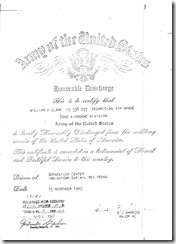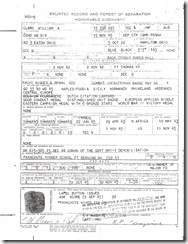In the spirit of the Holiday Season, I’d like to share a recording of Bill’s voice from Christmas 1942.
In 2006, I obtained access to a record of Bill’s voice wishing his family Merry Christmas from Camp Wheeler while he was at basic training in December of 1942. The disc was scratched and damaged by mold. I took it to my cousin, an expert in old records who was able to clean and resurrect the recording.
Below is a transcript of the conversation. If you’re interested in the history of the recording, please read on.
| William A. Clark Radio Announcement Christmas Day December 25, 1942 Transcription by Jeff Clark August 30, 2006 Announcer: Here comes now Private William A. Clark. Go ahead Bill, say hello to the folks there. Bill: Hello folks. I can’t say I have much to say after such a swell Christmas dinner. Here at Camp Wheeler they really feed well; not only on Christmas day, but every day. This camp is almost as good as it could be; good barracks, good officers – in other words it is almost like home. Before I enlisted in the Army people told me that is wasn’t so good, but I have found out that it’s okay and I think it is a privilege to be a part of it. I can’t think of much else to say, so I wish you all a Merry Christmas and a Happy New Year. Oh yes, and don’t forget to tell the folks in Hamilton and also Grandpa and Grandma Clark that I wish them a Merry Christmas. – Private William A. Clark. Announcer: Okay, now comes Private O. Preston Wilson from Fitz…….. [The recording cuts out at this point]. |
The Record’s History
In 2006, an old 78 rpm record came into my hands on loan from a family member. It was enclosed in a brown 9x12 envelope with 6 cents worth of 3 cent “WIN THE WAR” postage stamps on it. The mailing date was illegible. The envelope was addressed to the Parents of: William A. Clark, R. R. # 3, Eaton, Ohio. The record was labeled “CBS WHIO Dayton, Ohio”, “Christmas greetings from William A. Clark, Camp Wheeler” (See photographs below). From November 1942 through part of January 1943, Bill was stationed at Camp Wheeler, near the city of Macon, Georgia. In World War II, the camp was used as a facility where enlisted citizen soldiers completed a five week course in basic infantry training.
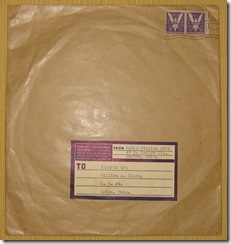
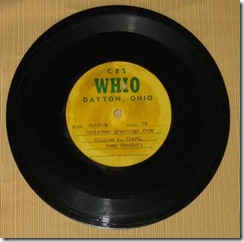

The surface of the disc was very moldy and had a prominent scratch in the shape of an arc that covered the first 1/3 of the playing surface. The scratch looked to me to be deep enough to make it unplayable. To my untrained eye the mold looked like it might have corroded the media beyond repair. Despite the damage, I thought it was worth the effort to see if it could be salvaged.
A lot of questions went through my mind over the ensuing days. If it was Bill’s voice what did he say? How long did he speak? What did he sound like as a young man?
Fortunately, I knew of someone who might be able to help. One of my cousins is an expert on antique analog recordings. He has a collection of over 5000 thousand old records including a large number of 78s. He is very well connected in the vintage music scene and knows several prominent specialists in the field.
On August 26, 2006, I met with my cousin over breakfast to assess whether the disc could be salvaged and digitized. I was keyed up to hear what he thought but braced myself for the worst. He inspected the record with the same look on his face that a diamond merchant has when examining the quality of a precious stone. I sat by helpless; anxiously looking time and again at the record then at my cousin for any sign of his final judgment. After a few minutes of careful scrutiny and some ominously raised eyebrows, he spoke. In his opinion the disc was about 45 - 50 seconds in length, was of a recording studio grade and made of metal covered in lacquer. Its delicate lacquered surface was designed to be played on state of the art high fidelity replay equipment of the 1940s. This equipment was only found in recording studios and radio stations and used sapphire or diamond styli. It was not intended for use with consumer grade 78 rpm players, which used abrasive steel needles. Consumer grade Shellac records were more durable, but the sound quality was not as good as their more fragile lacquered relatives. Judging from the width and angle of the scratch my cousin concluded that the disc was damaged because it had been played on a consumer grade Victrola record player. The Victrola had a needle which was too big and heavy for the fragile surface of the disc. He said that radio stations didn’t have the equipment or the blank Shellac discs available to make consumer grade records. As soon as the recording was made it would have been pressed onto the surface of a lacquer disc and was subsequently sent to Bill’s family. He said that because the recording was made on a high fidelity studio grade record, it was almost certainly the only one in existence.
Bill’s father, Henry Clark Sr. was well known for his love of records. In 1942 he owned a Victrola 78 player. In the summer of 1975, on a vacation from Australia, my family visited my grandparents on their farm in Ohio. I saw firsthand how much my grandfather enjoyed playing records on his Victrola. In the evenings he would pick out a couple of records, wind up the machine and play them. The records were big and thick. The needle of the Victrola looked to me to be dangerously sharp, so I didn’t want to investigate it too closely. I do remember it looked more than capable of playing those bulky records without skipping. Grandpa would play the records and we would all dance to old tunes from the 1920s and 30s. That ungainly windup mechanism, the oversized steel needle, the awkward looking gramophone, and the fact that surprisingly good music could come out of this contraption made a huge impression on me; one that has lasted to this day.
In 1942, when the record arrived in the mail, Grandpa, with his love of records was undoubtedly ecstatic at the prospect of playing it on his Victrola. I can envisage him now, taking it from its sleeve, placing it on the player, and turning the crank of the machine. Imagine his shock as he gently dropped the needle onto the spinning record hoping to hear Bill’s voice, but instead only getting the sound of a dirty great screech as the Victrola’s needle dug deeply into the disc’s lacquered surface, right through to the underlying metal. Poor guy; he wasn’t to know and apparently no one from station WHIO told him of the incompatibility issue. Amazingly, the broken record was kept for 62 years and wasn’t thrown out.
My cousin next examined the mold on the disc and determined that it had not damaged the playing surface. He said it could be removed with special cleaning fluid so as not to degrade the lacquered surface. In his opinion, the recording was damaged, but he thought it could resurrected. He told me about a 78 rpm record enthusiast friend of his whom had purchased new state of the art turn table equipment and audio restoration machines that were capable of retrieving sound from almost any disc. His friend had successfully coupled this mechanical equipment with digital recording devices. Using this combination of technologies, my cousin said he could work with his friend to salvage the recording. He said it would be difficult to find professional restoration artists with sufficient skill to restore the disc to acceptable fidelity. Of course other people could do it, but he said the resulting sound might be robotic and wouldn’t sound like natural voices. With the possibility that Bill’s voice was on the disc, my cousin and his friend appeared to offer the best solution. I gave the record to him and he promised to protect it with his life. As it turns out, this was the best decision I could have made.
My cousin stayed up all night on August 28, 2006, working with his friend’s specialized equipment retrieving and saving the good sections between the needle scratches. Then he combined the sequences and successfully reconstructed the entire recording by creating a digitized mp3 file.
On August 29 I called him and he said the effort was successful. I was relieved and elated at the news. He offered to play the recording over the phone. I drew in a deep breath as he pressed the play button. I heard static and then for the first time in almost 64 years Bill Clark’s youthful voice from 1942 crackled over the phone line. His distinctive tones even from so long ago expressed the same dry humor I had come to recognize and to cherish. As I listened, the potency of his youth coursed through me. I had the sense that this experience was a privilege. In those moments he was resurrected as a young man of 20 years. Together we transcended the gulf between then and now. We were transported to an eternal place where time itself having no purpose was absent. Before I knew it the recording fizzled out and Bill was gone. I lamented the fleeting mirage. Yet I was left with the precious sensation of meeting Bill as a young man; of sharing the enthusiasm and vigor of his youthful purpose.
Since that time, I have been given access to a letter, clarifying some of the mystery about the source of the recording and events surrounding broadcast of the message. The letter is dated December 21, 1942 from WHIO radio station in Dayton, Ohio (See scan of letter below), so the message had been recorded several days or perhaps even weeks before Christmas, 1942.
One day during this period Bill Clark had been standing in a line of soldiers at a recording studio possibly that of a radio station in Macon, Georgia. He was waiting to record his Christmas wishes to his family in Eaton and Hamilton, Ohio. The recording was to be sent to WHIO in Dayton for broadcast on Christmas Day.
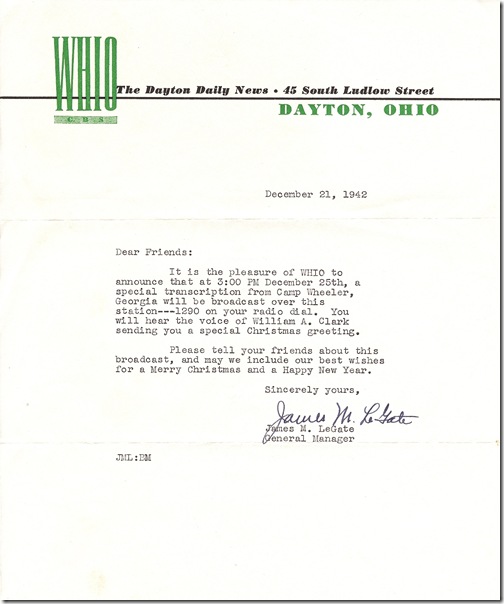
WHIO sent the letter to Bill’s parents so they could make arrangements for everyone to be present for the broadcast. On Christmas Day at 3:00 pm Bill’s family was tuned into WHIO awaiting the broadcast. They must have been gathered around the radio with baited breath in anticipation of hearing Bill speak to them on radio and on Christmas Day to boot. Bill was to be the first family member on the Clark side ever whose voice was to be broadcast over the airwaves. It was a special moment for everyone. The atmosphere had to have been charged with excitement in the Clark farmhouse.
An equally electric yet nervous atmosphere surrounded the young men waiting in line at the radio station during the time of the recordings. To speak to their families while a good portion of their respective communities were listening was unsettling for all but the most extroverted souls among them.
A recording of each soldier’s message was pressed onto on a 78 rpm record and posted to their local home town radio stations for broadcast on Christmas Day. In Bill’s case after it was broadcast, WHIO sent his recording onto his family for posterity.
Listening to Bill, it is evident that he read his previously written message aloud. It also seems reasonable to assume that he was briefed before composing the message on what were considered to be appropriate topics. I can imagine a hall full of young enlistees being lectured to on what to say and what not to say. Perhaps it went something like “You can talk about food, conditions at the camp, and make sure you take this opportunity to sell other un-enlisted guys on how good it is to be in the Army and what a privilege it is to serve your country.” I think Bill handled the situation very well with his joke about it being “almost like home.” This is Bill’s dry cutting sense humor to a ‘T.’ His ability to thumb his nose at authority whilst preserving the overall integrity of the system as he did here was to serve him well. His brand of individuality was exactly what Colonel James M. Gavin (commander of the 505) was looking for in his young would be paratroopers.
After completing basic training, Bill left Camp Wheeler to attend paratrooper school at Fort Benning, Georgia in January, 1943.
© Copyright Jeffrey Clark 2009 - 2010 All Rights Reserved.

